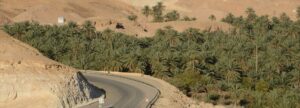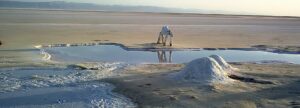Tunisia's capital and one of the oldest cities on the Mediterranean
The Tunisian capital is located in the northeast of the country on the Gulf of Tunis, separated from the sea by a lagoon and the shallow inland lake El Bahira, in the middle of which a tiny island bears the ruins of a former Spanish fort. Directly on the coast are the suburbs of La Goulette with the large port, the industrial town of Le Kram, the villa suburb of Carthage with an archaeological site and presidential palace, the picturesque artists' village of Sidi Bou Said and the seaside resorts of La Marsa and Gammarth. They are connected to the city by a causeway. Tunis itself has a population of over 1 million, and over 2,3 million people live in the greater Tunis area with all its suburbs.
Tunis is one of the oldest cities on the Mediterranean, but in ancient times the city was always overshadowed by the famous Carthage. Even before the Phoenicians reached the Tunisian coast, Tunis was a Berber settlement. It was only after the Arab conquest and destruction of Carthage in the 7th century that Tunis gained supraregional importance. Although the port was important for all previous conquerors, the favorable location between the inland lakes was more important to the Arab equestrian people. They built the olive tree mosque in the 8th century, and the last Aghlabid ruler, Ibrahim II, moved his seat to Tunis in 894. The subsequent Fatimids (Shiite-Ismaili dynasty) resided in Mahdia again.
In 1534 the Turks first reached Tunis. The Hafside El-Hassan fled and left the city to the attackers. Then the Spaniards landed at La Goulette in 1535 to drive out the Turks. After the victory, Tunis was cruelly plundered and El-Hassan was regained under the supervision of the Spaniards. Forty years later, however, Sinan Pasha finally conquered the city and the country for the Ottoman Empire and appointed a governor. For over 300 years, Tunis was the capital of the Ottoman province and the buildings were heavily influenced by the Turks. The Moors, expelled from Andalusia, also brought new businesses and prosperity and influenced architecture and art.
In 1881 the French invade Tunisia. The country becomes a French protectorate, and Tunis continues to be the seat of the Tunisian government, which it will continue to do after Tunisia gained independence in 1956. The European quarter between the medina and the El Bahira lake - the French embassy was built in front of the city wall as early as 1862 - was expanded in the European style with wide boulevards, administrative and commercial buildings and residential complexes in the countryside. After independence, many Europeans (mostly French and Italians) who had previously made up almost a quarter of the city's population emigrated. Tunis finally got a large population increase through the rural exodus, which led to the construction of numerous new building areas.
The Medina (historic old town): Traditionally, an Arab old town was clearly structured according to business branches, after which the narrow, labyrinthine streets are named. The mostly tiny rooms, closed at night by a heavy wooden gate, serve as a workshop and shop at the same time. The dealer sits on a carpet in the middle of his goods, the cap maker in the Souk El-Chechia combs the felty, red model and sells it at the same time. Djellabas (hooded coats) are provided with fine embroidery in 1 x 2 m small rooms by nimble fingers.
Away from the main tourist street, the Medina of Tunis still offers tourists this centuries-old image; it also has over 700 historical buildings, including over 100 former palaces of wealthy merchants and officers, 200 mosques, a good 100 mausoleums and 40 Koran schools, making it unique in North Africa .






